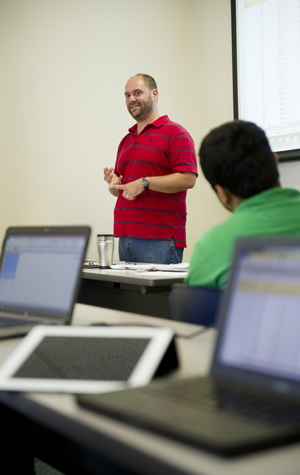Your Financial Life Explained
CAS economics class teaches key life lessons

Class by class, lecture by lecture, question asked by question answered, an education is built. This is one of a series of visits to one class, on one day, in search of those building blocks at BU.
The course description for Aaron Stevens’ economics class should read: “Take this and you’ll be prepared for every decision you make from now until death.” That may be a tad dramatic, but it’s not far off base, considering that students learn how to use applied economics to make decisions on spending, saving, borrowing, choosing careers, marriage, reproduction, and retirement. And that’s just the short list.
“The economic system has grown up without a specific plan for educating people how to get a fair shake and get the best deal,” says Stevens, a College of Arts & Science lecturer in economics and computer science, who wrote the class’ eponymous text, Personal Life Cycle Economics. “If you can help people understand the process, then the life cycle model is the clear way to do this decision-making.”
Stevens’ class is so popular it fills immediately, usually with upperclassmen for whom the job hunt is uncomfortably close. Nationwide, the unemployment rate for college graduates was nearly 4 percent in April 2012, about half that of the general population, but still of particular concern for the two thirds of students who have borrowed money to pay for college. About 57 percent of BU graduates carry debt, which averaged nearly $36,500 in 2011, according to the Project on Student Debt, an initiative of the Institute for College Access & Success. Nationwide, college grads are left with an average debt of $26,600.
Consumption smoothing, or learning how to evenly spread earnings over a lifetime, is key to solid financial planning, Stevens says. When people are young, they work and save money. When they’re old, they retire and spend down savings. The life cycle model is based on this concept, but also considers how the federal tax code, benefits, loans, and retirement plans interact with saving and spending over time. Most people can’t tackle this complex equation by themselves. That’s where Stevens’ class comes in.

During one class, students trickled into a nondescript classroom in the Math and Computer Science Building as an Eric Clapton video with Japanese subtitles played on a whiteboard. Most students are men, an oddity at BU, where 60 percent of the student body is female. They chatted with Stevens, dressed in jeans and a red-and-blue striped polo shirt, and discussed the latest quiz before jumping into that day’s lesson: How Your Relationship with Uncle Sam Affects Your Consumption Smoothing. Stevens scribbled three income scenarios on the whiteboard:
Engineer, $110,000/year
Hedge Fund Manager, $10 million/year
Warren Buffett, $1 billion/year
“Your tax rate depends on how you earn income,” Stevens said.
Most Americans, he explained, produce goods or services and receive a salary subject to federal income tax rates, with the engineer’s falling around 28 percent. Professional investors, like hedge fund managers, make money through the sale of stocks and bonds, which is subject to a capital gains tax of 15 percent. And wealthy individuals, like Warren Buffett, can avoid taxation by carefully moving around assets so it appears they’ve earned nothing.
Here Stevens paused and scanned the room. He called on Amanda Robertson (CAS’12), who silently stewed in her seat.
“I’m so mad!” Robertson said. “People who are actually working at something are the people who have to pay more taxes. It just seems really unfair.”

But other students (potential hedge fund managers?) requested that Stevens look at each worker’s total tax amount instead of their rate. He obliged and wrote more figures on the board:
$30K
$1.5M
None
Stevens wanted the class to see how this tax discussion applied within the life cycle model. He wrote an equation on the whiteboard that looked like algebra on steroids—each letter representing consumption, income, savings, taxes, and benefits—to discover how much a hypothetical single worker should save for a comfortable retirement. Then he plugged a random savings amount into the same equation, this time preprogrammed in Excel, to see what popped out.
“What’s the implication of saving more money?” he asked as everyone reviewed the numbers. “The more you save, the more taxes you pay,” because of asset growth. Again, students squirmed in their seats. “Our current system effectively has a disincentive to save.”
Stevens continued to tinker with the equation by lowering annual savings until the hypothetical worker reached a happy equilibrium of income, consumption, taxes, and savings ($0) in retirement.
“Something’s wrong if we’re saving in retirement,” he explained, adding that there’s no reason to save money forever. The whole purpose of saving when young is to live comfortably when old. “Unless you want to leave three-quarters of a million dollars to BU, you saved too much.” He offers another piece of advice as well: plan to live to 100: “Assume the maximum longevity. The worst case is outliving your assets.”

The scenario Stevens hammered out was for a single person without any loans, but financial plans get murkier once other variables—like marriage, children, and mortgages—get thrown into the equation. For that, he opened another financial program, called the Economic Security Planner, a tool developed by Laurence Kotlikoff, a William Fairfield Warren Distinguished Professor and CAS economics professor. He ran through several scenarios for singles and married couples by adding imaginary children, mortgages, and generous uncles who bestowed fat inheritances, then discussed when—if ever—life insurance was necessary.
“The real world will not always be exactly the same,” Stevens said, but software like this provides a framework for how to wisely spend and save over a lifetime.
Thomas Chan (CAS’14, SMG’14) plans to take that lesson seriously. He said that his sister lives paycheck to paycheck, never fully managing her money. “I don’t want to be like that,” he said.
Robertson, who wants to pursue humanitarian work, felt reassured about her future. “Even at lower levels of income,” she said, “you can still live a life that’s relatively comfortable as long as you plan for it.”
Personal Life Cycle Economics, CAS EC171, is being offered this fall on Tuesdays and Thursdays from 12:30 to 2 p.m.
Free versions of Laurence Kotlikoff’s Economic Security Planner are available online.
This Series
Also in
One Class, One Day
-
November 30, 2018
Breaking Bad Director Gives CAS Class the Inside Dope
-
October 31, 2018
Trump and the Press: We’ve Been Here Before
-
August 3, 2018
A Scholarly Take on Superheroes

Comments & Discussion
Boston University moderates comments to facilitate an informed, substantive, civil conversation. Abusive, profane, self-promotional, misleading, incoherent or off-topic comments will be rejected. Moderators are staffed during regular business hours (EST) and can only accept comments written in English. Statistics or facts must include a citation or a link to the citation.